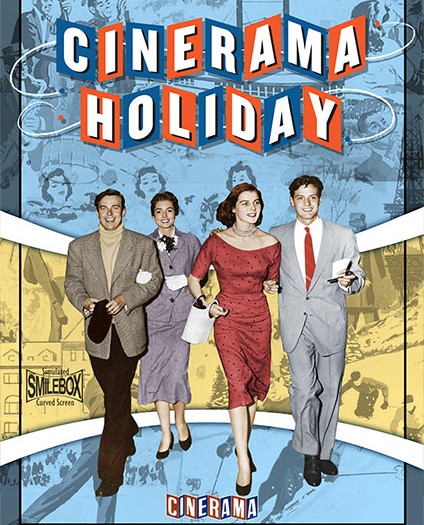In 1954, Betty and John (Johnny) Marsh embarked on a dream tour through Switzerland and France. The result was the spectacular travelogue Cinerama Holiday, the highest-grossing box office hit of 1955. Today, Betty Marsh York was kind enough to give Flicker Alley a behind-the-scenes look into the making of Cinerama Holiday. In Part 1 of a two-part installment, Betty describes her naiveté, snapshots of daily life not captured on camera, and working with celebrated producer Louis de Rochemont (The March of Time, The Fighting Lady).
Chosen because they represented a quintessential Middle American couple, the Marshes had no idea what was in store for them when they signed onto the film. They were not only left in the dark about what they would see and do on their European holiday, but also had no idea how long the shoot would last!
[The Cinerama producers] didn’t tell us anything. We had no expectations whatsoever.
We arrived in Switzerland around the 1st week of January [and soon left for France to shoot interior scenes before returning to Switzerland.] We spent 4 to 6 weeks in Switzerland where they were doing the ski scenes. They saved the French exterior shots for after Switzerland.
It never occurred to me to try to learn French. When we got to Paris, we had no idea how long we would be there. They had to wait until the chestnut trees bloomed to do any of the exterior shots. It was a very late winter; the trees didn’t bloom. We didn’t leave Paris until the 5th of June – that’s how late everything was!
No one said “you’re going to be here until June 5th” because [the producers and crew] didn’t know [how long it would take].
Having never left the country before, the Marshes relied on the famous Fielding Travel Guides to learn more about European sites and culture.
We did buy the Fielding Guide beforehand. It warned us that “toilet paper was a cross between the Sears Catalog and wax paper and you’d well-advised to bring Kleenex and tissue from home.”
Advice that Betty was very glad they followed! On the home front, Betty and Johnny went to some interesting lengths to stretch their per diem.
In Paris, we stayed in a small little hotel on the Left Bank that is now a Best Western. But we went everywhere. We found a big department store that had a whole floor of housewares. We bought a little alcohol stove and would buy canned beans and baguettes and cheese and pâté. Our hotel had a great huge old-fashioned bathroom with a great tub up on long feet and we turned that into a kitchen.
When the Marshes first arrived in France, their palates were not exactly accustomed to the gastronomic wonders Paris had to offer – a recurring theme throughout their trip.
We heard you could get reasonably priced hamburgers at the American embassy. And being as naïve as we were, we thought you could just get in. In line outside, we met Larry Carpenter from South Orange, New Jersey. We said, “We heard they have really good hamburgers here.” He invited us in and we ended up eating at the embassy all the time.
We didn’t even drink wine. Both of us came from teetotaler families. And I only liked things that tasted sweet. Somebody had introduced me to a dessert wine, Sauternes. Nobody drinks it anymore. You would only drink it after dinner, but I was drinking it with dinner. What the waiters must have thought!
The first dog I saw in Paris was of all things a French poodle. He belonged to the proprietor of a fruit shop. We purchased an orange from the street – right out in the open! They didn’t have open markets in Kansas City, Missouri. “A better orange was never found stateside!” [Betty proclaimed in her 1954 travel diary.]
The Marshes used the money they saved to buy a French poodle like the shop owner’s. The same adorable French poodle Betty is seen holding on their voyage back to the States. But they did splurge on finer dining.
We had pressed duck which was the thing to eat at [historic restaurant] La Tour d’Argent. [Washington Post humorist] Art Buchwald [featured in the bedroom scene] had written a book about all the restaurants of every variety in Paris. Johnny and I just went through the book and we ate Chinese, Japanese, Russian – in every ethnic variety just to break up the French.
Behind the scenes, Betty and Johnny got to know the Cinerama crew.
The crew was really friendly and we loved [Richard J.] Putschman, the sound guy. The crew was wonderful with us. We really liked all the crew. We’d be standing around, waiting to do something, and we’d visit with them and talk with them.
There were a couple young guys who were assigned to us. One guy took us to a cheapie restaurant in Paris. Tripe was on the menu and we didn’t know what it was and neither did this young American. Johnny said, “I think it’s fish.” It’s cow intestine. When it got to the table, it looked like a blob of fat. We stayed away from really cheap restaurants after that!
Tripe wasn’t the only new delicacy the couple was introduced to. Cinerama Holiday producer Louis de Rochemont and his wife, Virginia, dined with the Marshes at a few more upscale establishments.
Mrs. de Rochemont was in Paris with us. She was a sculptress and she would go somewhere where she would do her art every day. But [the de Rochemonts] did take us out to dinner a few times. I was horrified because she liked raw oysters and she would tip the shell up and drink all the juice.
Of course, the more sophisticated Betty of today would follow suite! In her travel diary, Betty described how nervous she and Johnny were to meet Louis de Rochemont for the first time.
[My diary] talks about how fearful we were when we knew we were finally going to meet Mr. de Rochemont in Paris because we knew he was such a great director. We’d seen movies he’d done. We’d seen Walk East on Beacon. He launched Mel Ferrer’s career. De Rochemont only worked with unknowns; he didn’t want stars or people with long resumes. We were afraid he wouldn’t like us and they would then send us home.
Big Louie and his wife were rather austere. They were the bosses.
Betty kept in touch with Louis de Rochemont and his son when she came to New York to model a few years later. Or Big Louie and Little Louie, as she calls them. The crew, however, had another nickname.
The crew referred to Little Louie as Troisième since he was Louis de Rochemont III.
Though wide-eyed and a bit naïve when they arrived, Betty and Johnny did not let their lack of worldliness keep them from experiencing firsthand the unique sites Paris had to offer.
There was one Frenchman on the crew and he was marvelous. He made sure we knew about the Place des Vosges and we dutifully went there. We found a favorite restaurant under the Joan of Arc statue in gold. They had the best steak.
I visited a perfume shop on the Rue de Rivoli and bought beautiful leather gloves. People were so kind to us. We were so unique. There really were no tourists in Paris in the wintertime. There just weren’t.
To learn more about the Marshes’ experience as two tourists in Paris filming Cinerama Holiday, check out Part 2 of our interview with Betty Marsh York on Flicker Alley’s blog The Archives next week. For more behind-the-scenes tidbits, check out the special features on the Cinerama Holiday Blu-ray/DVD Combo!


